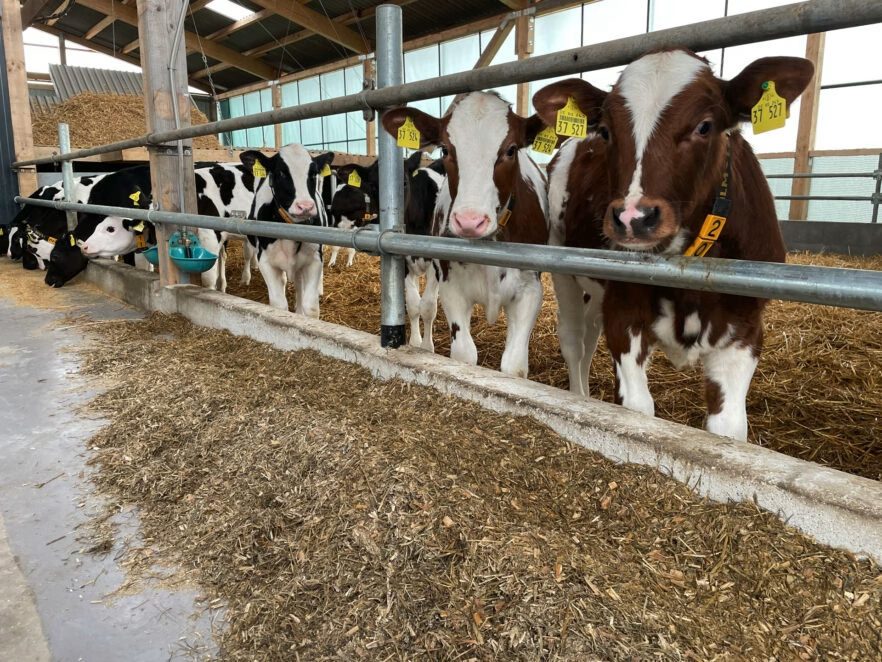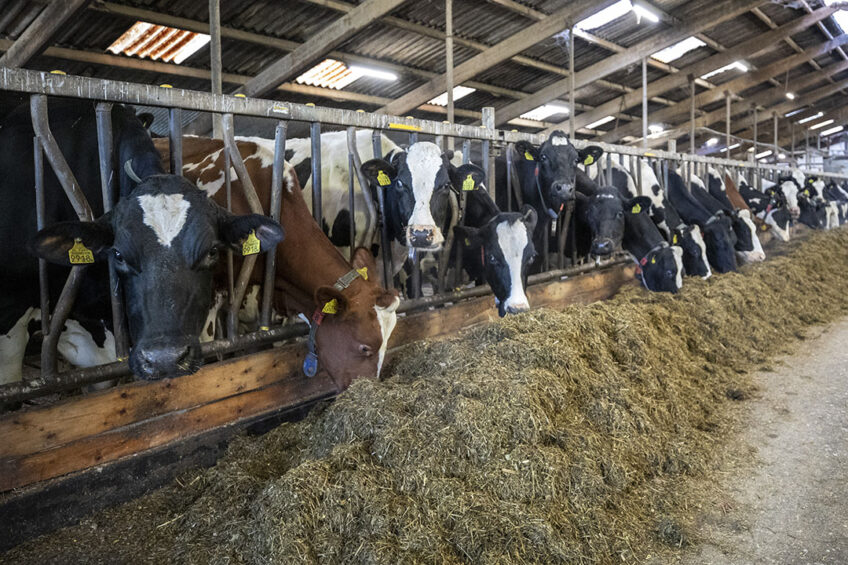Discover optimal heifer growth strategies with TMR diets. How can early nutrition impact your dairy herd’s success? Learn expert tips for healthier, productive cows.

Optimal growth in heifers is essential for dairy success. Ensuring young heifers develop well during their early months sets the stage for productive and healthy future cows. This early growth phase is crucial as it directly impacts milk production and long-term health. This article explores the benefits of feeding young heifers a high-cow Total Mixed Ration (TMR) diet, a method endorsed by Tom Tlyutki from Ag Modeling and Training Systems.
Tlyutki emphasizes that young heifers should be fed similarly to high-lactating cows to meet their nutritional needs and achieve optimal growth. This approach involves:
- Transitioning from calf starter to TMR by top-dressing a fixed amount of starter
- Formulating a diet that mimics a high-group ration, even without a lactating herd
“Dairy heifers under 6 months of age have the same nutritional needs as a cow giving 90 pounds of milk,” says Tlyutki. “Feeding them a high-cow TMR diet ensures they grow properly and are well-prepared for future lactation.”
Nourishing Young Heifers: The Foundation of Future Milk Producers
Ensuring proper nutrition for dairy heifers under 6 months of age is essential. These young animals have nutritional needs comparable to a mature cow producing 90 pounds of milk daily. This means they require high energy, protein, and essential nutrients, much like their high-producing counterparts.
Transitioning from calf starter to a total mixed ration (TMR) is crucial in their development. One effective method is to top-dress a fixed amount of calf starter onto the TMR. This gradual transition helps the young heifers adjust to the new diet seamlessly, maintaining consistent nutrient intake and supporting steady growth.
Simulating a High-Group Ration for Heifer Raisers Without a Lactating Herd
Feeding heifers without a lactating herd starts with understanding their nutritional needs, similar to those of high-producing cows. The aim is to provide a nutrient-rich diet to promote growth before lactation begins. This can be achieved by mimicking a high-group ration typically fed to top milk producers.
Begin by gradually transitioning from calf starter to a Total Mixed Ration (TMR) by top-dressing a fixed amount of starter. The TMR should balance roughage and concentrates to support rapid growth, emphasizing bypass starch for efficient nutrient use.
Including more low-nutrient-dense roughage is essential. It provides necessary fill without causing excess fat, which can lead to metabolic issues. Maintaining lactic acid content below 4% is crucial to avoid acidosis.
Investing in proper nutrition helps achieve tripled birth weights by 90 days, setting a solid foundation for future high producers. Early growth before pregnancy leads to better health and productivity.
Simulating a high-group ration requires careful planning and commitment to balanced, high-quality feed. This ensures efficient growth and a seamless transition into lactation, contributing to a more productive dairy herd.
Key Growth Milestones for Holstein Heifers: Building a Solid Foundation
When managing a big Holstein cow, aim for crucial growth milestones. A Holstein should weigh about 285 pounds at 90 days old and around 1,045 pounds by breeding age. These are essential markers of healthy growth.
Focus on tripling the birth weight by the 90-day mark. This rapid early growth is vital, as it sets the foundation for the heifer’s future productivity. Meeting these benchmarks prepares the heifer for pregnancy and lactation, contributing to her health and the herd’s efficiency.
Unlocking Heifer Potential: Prioritizing Early Growth for Future Productivity
Early growth is paramount for heifers to unlock their full potential as productive milk cows. Addressing their nutritional needs from day one ensures a strong foundation for growth and future milk production. To achieve high milk yields, like 228 to 247 pounds per day for a 1,900-pound cow, it’s crucial to triple a heifer’s birth weight in the first 90 days. This rapid early growth is critical because once heifers become pregnant, further growth becomes difficult. Focusing on early growth impacts their size, productivity, and overall health in the long term.
Roughage: The Unsung Hero in Heifer Health and Development
Tlyutki recommends giving heifers plenty of low-nutrient-dense roughage like hay or straw. This may seem counterintuitive, but it helps maintain rumen health and prevents excessive weight gain. Roughage provides bulk, promotes satiety, and aids in rumen development. It also prevents overeating of high-nutrient feeds that can lead to metabolic issues.
Focusing on roughage helps heifers develop a healthy digestive system, which is crucial for processing more complex diets later. This also helps avoid acidosis, a condition triggered by high-starch diets. The goal is steady, sustainable growth without stressing their developing bodies, laying a solid foundation for future milk production.
Quality Over Cost: Tlyutki’s Stance on Calf Starters
When it comes to cheap calf starters, Tlyutki has strong reservations. He firmly criticizes these starters, which are often laden with excessive amounts of corn. While they might appear economical initially, these corn-heavy formulations can quickly lead to acidosis. Acidosis is a metabolic condition characterized by an excess of acid in the bloodstream, which can severely compromise the health and development of your heifers.
Avoiding these inexpensive starters is essential for preventing a range of health issues. Heifers fed these corn-centric diets can suffer from reduced feed efficiency, digestive disturbances, and poor growth performance. The key lies in the quality of the feed, not just the price. Investing in higher-quality calf starters with balanced nutritional content ensures that your heifers develop robustly, setting a solid foundation for their future productivity as milk producers.
Balancing Bypass Starch and Lactic Acid: Tlyutki’s Blueprint for Thriving Heifers
Tlyutki’s approach advocates feeding a substantial amount of bypass starch to raise healthy and fat heifers. This specialized type of starch isn’t fermented in the rumen. Instead, it bypasses it, reaching the intestines where it gets absorbed efficiently. This helps to provide a steady energy source that’s less likely to cause digestive issues commonly associated with high-starch diets, such as acidosis.
Moreover, he recommends maintaining lactic acid levels at 4% or less. High lactic acid in the rumen can lead to acidosis and other metabolic problems, impeding growth and overall health. By controlling lactic acid levels, you can prevent these issues, ensuring that your heifers grow into strong and productive cows. Combining adequate bypass starch with controlled lactic acid levels supports optimal growth by maximizing nutrient absorption and minimizing health risks.
Maximizing Economic Benefits Through Strategic Heifer Growth
Growing heifers “right” offers substantial economic benefits. Prioritizing their early growth cuts rearing costs and frees up resources for other critical areas of your dairy operations.
Healthier heifers grow faster, increasing rearing capacity and accelerating their contribution to milk production. Investing in their early growth reduces long-term expenses and improves system efficiency.
This approach ensures your heifer’s health and productivity, strengthening the economic stability of your dairy operation.
The Bottom Line
Optimal heifer growth is crucial for dairy success. Implementing a high-cow TMR diet ensures your young heifers receive the same nutritional care as high-producing cows. Transitioning from calf starter to TMR and emphasizing early growth can significantly enhance their potential. Prioritizing low-nutrient-dense roughage and choosing quality calf starters are vital strategies. Balancing bypass starch and lactic acid levels prevents health issues and promotes thriving heifers.
Investing in these strategies can yield significant economic benefits, accelerating heifer development and boosting overall farm profitability. Implementing these practices supports optimal growth and sets the stage for more productive and efficient dairy operations. Transition today for a brighter dairy future.
Key Takeaways:
- Younger heifers have nutritional needs akin to high-lactating cows, necessitating a high-cow TMR diet.
- Transitioning from calf starter to TMR by top-dressing a fixed amount of starter is recommended.
- A 1,900-pound Holstein cow requires a weight of 285 pounds at 90 days and 1,045 pounds at breeding for optimal growth.
- Tripling the heifer’s birth weight by 90 days of age is advised.
- Early growth is vital for heifers to reach their full productivity potential.
- Low-nutrient-dense roughage is beneficial for early heifer growth.
- Avoid cheap calf starters with high corn content to prevent acidosis.
- Incorporate bypass starch in the diet, aiming for 4% lactic acid or less, for healthier growth.
- Strategic heifer growth can reduce rearing costs and enhance productivity.












